Introduction
Overall Design
{{section_header}}{{section.name}}{{/section_header}}
The LG 47LX6500 is a good looking TV, if not a little ordinary. The frame is made of highly reflective black plastic.
Front
{{section_header}}{{section.name}}{{/section_header}}
The front of the LG 47LX6500 is mostly screen, with a series of touch-sensitive controls along the bottom edge. While conveniently placed, they are most definitely fingerprint magnets.

Back
{{section_header}}{{section.name}}{{/section_header}}
The back of the LG 47LX6500 is home to all the ports.

Sides
{{section_header}}{{section.name}}{{/section_header}}
The LG 47LX6500 is clearly thin, making for an attractive TV, on the whole. From the left side, you can see some of the ports. They're set far enough back from the edge that wires sticking out of here might be pulled back so they aren't visible to the viewer, depending on the thickness of the wire.

Stand/Mount
{{section_header}}{{section.name}}{{/section_header}}
The base is wide and sturdy, and feels quite heavy duty – a good thing considering the weight and size of this TV.
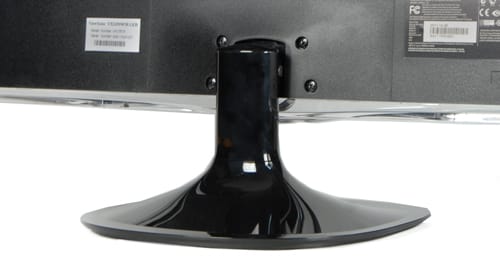
Controls
{{section_header}}{{section.name}}{{/section_header}}
The controls that run along the bottom are so inoffensively blended into the frame that you may not be able to see them. It's just as well, because they pick up fingerprints like nothing you've ever seen.

Remote Control
{{section_header}}{{section.name}}{{/section_header}}
The remote control is long and thin, generally comfortable and easy to use. Most of the buttons are large and rubbery, but we prefer the smoother, faster buttons in the center, those that control the menu.
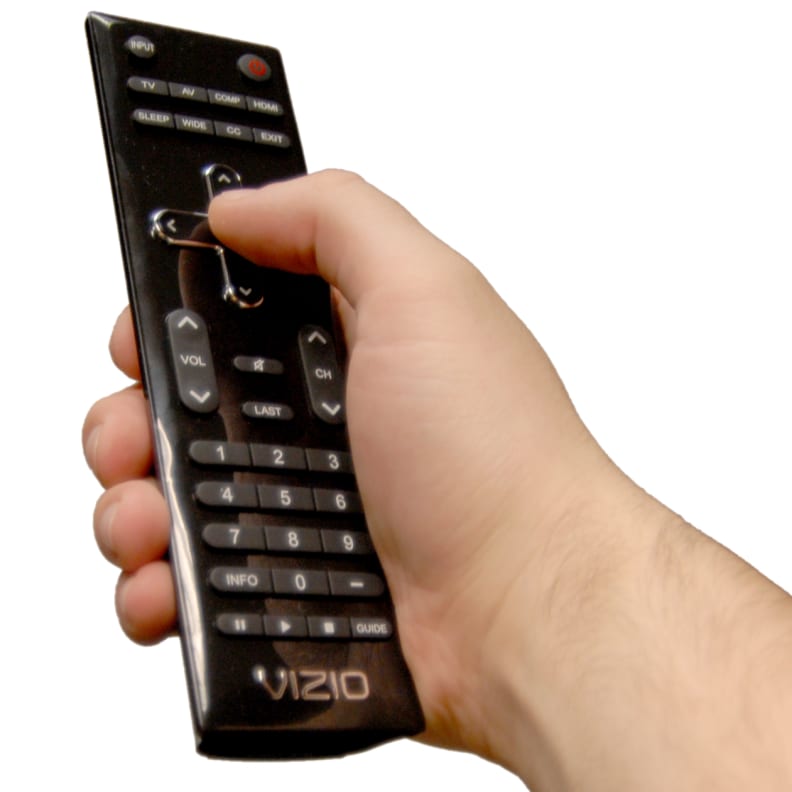
In the Box
{{section_header}}{{section.name}}{{/section_header}}
The LG 47LX6500 ships with the stand, remote control, batteries, some light documentation, and an adapter for the one oddly-shaped component AV input (there are two other normal component AV inputs, as well). The LG 47LX6500 does not come with 3D glasses or a compete instruction manual.
Black Level
{{section_header}}{{section.name}}{{/section_header}}
The black level on the LG 47LX6500 was not great, which has been the case for most of the LG's we've reviewed recently. Part of the poor performance could be explained by our calibration, which turns the backlight all the way up (for best color), but as you can see from the chart below, similar TVs did not suffer the same problem under the same calibration.
Under normal viewing conditions, you're not likely to look at the TV and decry a terrible black level. But were you to put it next to the other TVs mentioned here, you'd notice a difference. If you love LG, but feel iffy about the black level, take heart that the color performance is outstanding. More on how we test black level.
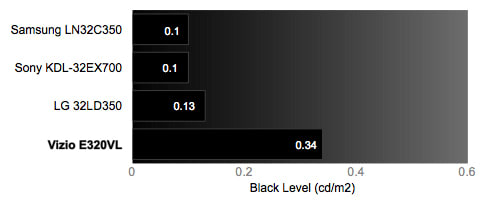
Peak Brightness
{{section_header}}{{section.name}}{{/section_header}}
LG 47LX6500 had an average peak brightness. At 327.84 cd/m2, that's plenty bright, even in a sunny room. It's typically plasma displays, like the Panasonic TC-P50VT20, that have problems with brightness. More on how we test peak brightness.
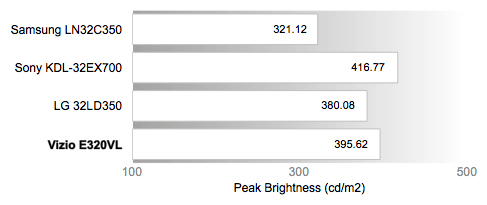
Contrast
{{section_header}}{{section.name}}{{/section_header}}
The contrast ratio on the LG 47LX6500 was hindered by the poor black level performance – only 941:1. That's significantly narrower than the competing televisions in the chart below.
The LG 47LX6500 offers local dimming, meaning that certain regions of the screen can have backlighting different from the adjacent regions. It's unclear just how many regions there are. We turn local dimming off during testing because it tends to throw the test results. But you should feel free to experiment with it, as different conditions yield different results. More on how we test contrast.
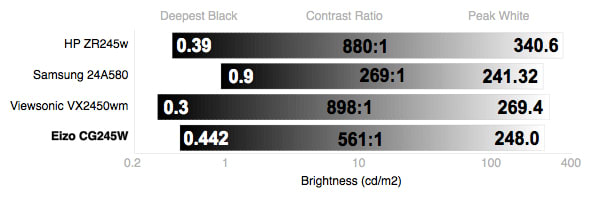
Tunnel Contrast
{{section_header}}{{section.name}}{{/section_header}}
The tunnel contrast test indicates how well a TV maintains a consistent black level, no matter how much or how little of the screen is black. The LG 47LX6500 performed well on this test, as do most LCD displays. It's usually just plasmas that have trouble. More on how we test tunnel contrast.
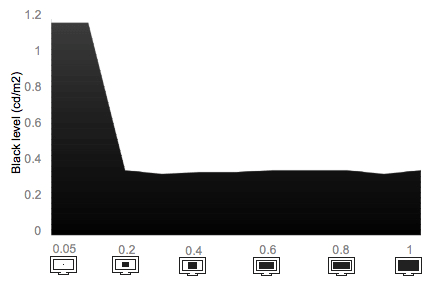
White Falloff
{{section_header}}{{section.name}}{{/section_header}}
The white falloff test measures how well a TV maintains a consistent peak brightness, no matter how much or how little white is on the screen. The LG 47LX6500 performed near-perfectly. More on how we test white falloff.
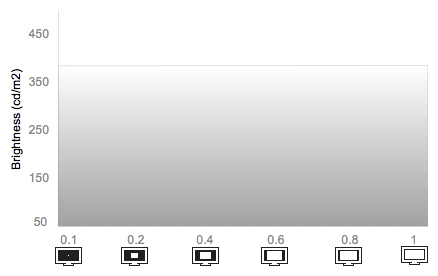
Uniformity
Greyscale Gamma
{{section_header}}{{section.name}}{{/section_header}}
The greyscale gamma test determine how well a TV transitions from black to white through the greyscale. We're looking at a few things in the chart below. First, the smoothness of the line indicates that the lg 47LX6500 doesn't make any huge leaps from one level to the next, so you won't see any banding in the transitions. The flatter, horizontal stretch in the lower left indicates that the LG has some troubles finding details in the shadows, but we've seen worse.
There's also the slope of the curve. A 2.73 slope is steeper than we'd like. Ironically, the 47LX6500 lets you 'pick' the desired gamma slop. We chose 2.2, which would have been ideal, and 2.73 is what we actually got when we tested. More on how we test greyscale gamma.
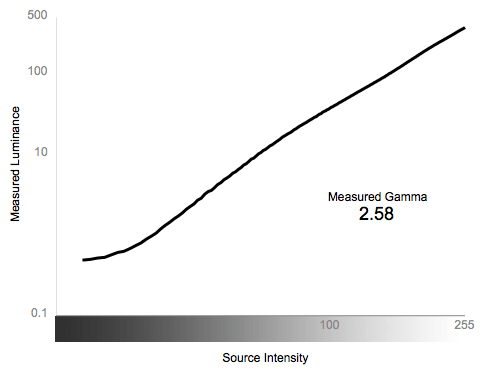
Color Temperature
{{section_header}}{{section.name}}{{/section_header}}
The color temperature of the LG 47LX6500 was fairy consistent throughout the signal range. As you can see from the chart below, there's a tendency for the whites to get a little warm, but it only brushes into the range of visible error. More on how we test color temperature.
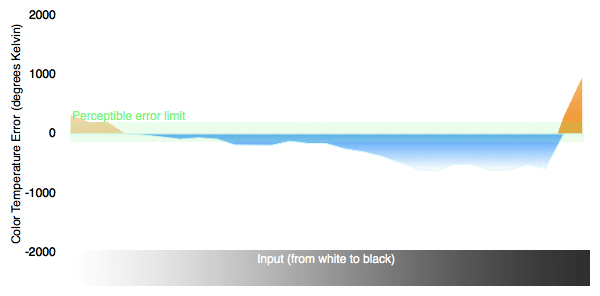
RGB Curves
{{section_header}}{{section.name}}{{/section_header}}
The LG 47LX6500's color performance was characteristically excellent, as it was with all the LG's we've tested recently. One look at the color curves in the chart below shows how good it was. The red, green, and blue channels move in almost perfect tandem. The lines are quite smooth, except for a couple notable hiccups in the blue channel. There are instances in the left-most and right-most stretches of the lines that appear horizontal. It shows that the TV has some trouble displaying details in the darkest and brightest parts of the signal. Overall, though, it's an excellent performance. More on how we test RGB curves.
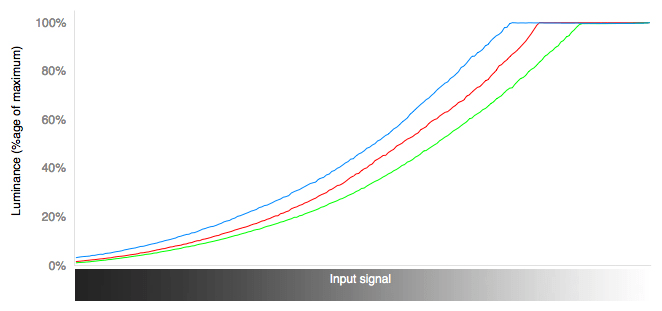
The color strips below are digital recreations of the test above. Note how rarely a TV manages to produce the amount of shadow detail seen in the 'ideal response' strip.
Motion Performance
{{section_header}}{{section.name}}{{/section_header}}
Motion Smoothness (7.0)
The motion performance of the LG 47LX6500 was, on the whole, rather good. In order to get the smoothest motion, we experimented with the TruMotion feature, which is standard on most LG TVs. The feature has a way of preventing jaggies and flickering that otherwise appear on most objects in motion. The TruMotion feature helps retain fine detail in these objects, too. However, there's a downside. Movies and other high-end, film-like productions can take on a strange, cheap video-ish look. We recommend knowing what the feature is and how to turn it off.
Motion Artifacting (6.25)
The LG 47LX6500 produced noticeable artifacting when all the special processing features were off. We noticed loss of fine detail, obscured by flickering and jagged lines. The severity of the problem varies widely depending on the complexity and speed of the moving objects. When we turned the TruMotion feature on, most of these problems disappeared, but other issues occurred. Most notably, film takes on a strange, video-like look. More on how we test motion performance.
3:2 Pulldown & 24fps
{{section_header}}{{section.name}}{{/section_header}}
The LG 47LX6500 can handle 24fps video with no problems. When we looked at the screen displaying some challenging test patterns, there were almost no problems. We noticed some minor stuttering effect during left-right pans of the camera, but overall, it was quite good. More on how we test 3:2 pulldown and 24fps.
Resolution Scaling
{{section_header}}{{section.name}}{{/section_header}}
The LG 47LX6500 has a native 1080p (1920 x 1080) resolution, but most of the content you'll be looking at is of a lower resolution. It's up to the TV's processing to take that video and upscale it to the screen resolution. Many TVs don't perform this task to well, but the LG 47LX6500 was rather good. More on how we test resolution scaling.
480p
Video in the 480p format lost 1% of the image on all sides due to overscan. There was also some loss of detail in high frequency vertical patterns, which became solid blocks of color.
720p
The 720p video we looked at had no overscan loss, and was nearly perfect in its display quality.
1080i
Video in the 1080i format showed slight Moire patterns in high frequency patterns, but there was no loss due to overscan.
3D Effect & Experience
{{section_header}}{{section.name}}{{/section_header}}
We think LG really dropped the ball with the 47LX6500's 3D effect. None of the current generation of 3D HDTVs is very good, but the LG's is bad to the point of needing a firmware update. For starters, there's no way to calibrate the TV once its in 3D mode. In fact, you can't really do anything without turning 3D mode off first. This is especially annoying since you're locked in to a calibration mode that appears to keep motion processing on. We definitely noticed some sort of timing issue between the left and right 3D channels, and it could be caused by motion processing. Between the crosstalk and other issues, the 3D effect drops out constantly and inconsistently, making some scenes downright painful on the eyes. Further, we noticed the TV seems to flash green or acquire a dot crawl effect when the 3D mode is on. At its worst, the image strobed between the intended image, static, and flat green.We ran into the problem less when the TV was hooked up to an LG-branded Blu-ray player, but it still cropped up from time to time. If you're buying this TV, definitely get the LG Blu-ray player with it to cut down on this issue.
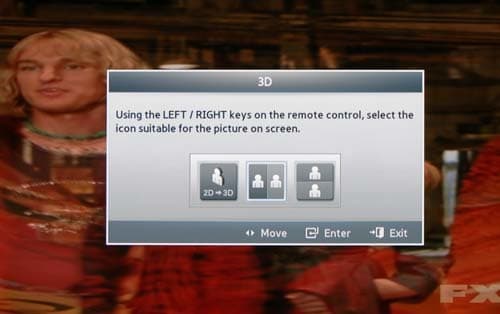
Some of the options in the 3D menu
3D Black & White
{{section_header}}{{section.name}}{{/section_header}}
Switching 3D mode on typically does bad things to picture quality, especially to the TV's contrast ratio. Initially, the LG 47LX6500 had a mediocre black level of 0.36 candelas per square meter (cd/m2). In 3D mode the black level dropped a bit, but the peak brightness absolutely plummeted: it dropped from 327.84 to 56.06. We typically see horrible contrast ratios in HDTVs displaying 3D content, but this was even bad for that group.
Here's some handy links to the 3D performances of other manufacturers' flagship 3D HDTVs: Panasonic, Samsung, and Sony.

3D Color
{{section_header}}{{section.name}}{{/section_header}}
The 47LX6500's color temperature was very noticeably cool. For the most part the color shift was uniform, but the odd spikes and dips make some shades look either more blue or more red than they should.
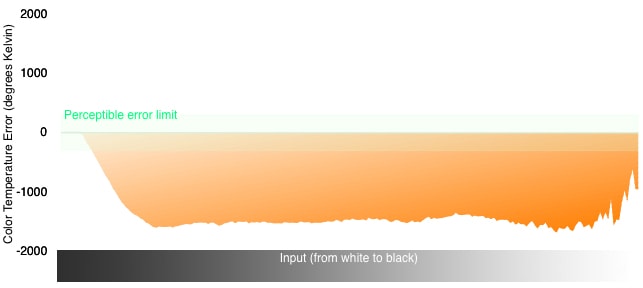
Heavens to Betsy! Look at that RGB graph! We ran this test several times because we couldn't believe the results. Consistent results and our own eyes confirmed it, though: the red and blue in 3D mode are downright horrible. They hit peak luminance about half way through their spectra, meaning there's a tremendous amount of lost detail in both channels. If you look at a gradient on the screen that displays all 255 possible shades of red and blue, you can clearly the brighter half is just flat color. LG typically scores better than other manufacturers on our color tests, so the 47LX6500s' poor RGB representation are surprising.
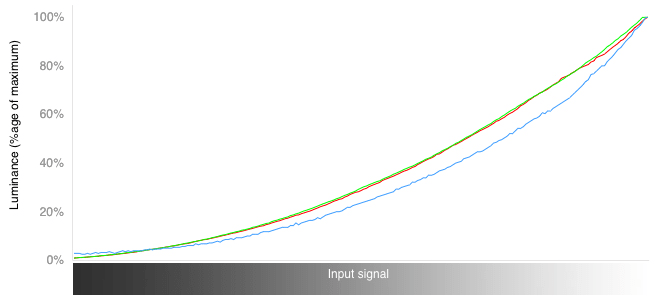
The TV didn't have too much trouble with its color gamut, thankfully. The green got a bit oversaturated and the blues were slightly undersaturated, but considering the 3D performance is essentially uncalibrated, we thought it was pretty good.
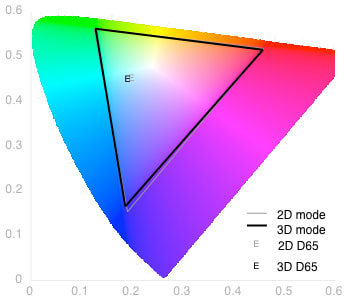
3D Crosstalk
{{section_header}}{{section.name}}{{/section_header}}
Current 3D technology depends on the TV flickering between images intended for your left eye and images intended for your right. The 3D glasses flicker in sync with the TV, so your right eye doesn't see the image intended for the left and vice versa. Crosstalk is when the TV can't quite keep the left and right separate.
The LG 47LX6500 had some serious issues with crosstalk, to the point where it really breaks down the 3D effect. The TV really had a problem separating out dark colors. Any time a dark object was in a bright area, it would be flanked on either side by half-shadows of itself. This effect caused specific areas of a 3D object to suddenly lose their 3D effect, which really exacerbated eyestrain.
3D Glasses
{{section_header}}{{section.name}}{{/section_header}}
We didn't have any real problems with LG's 3D glasses. They felt a bit cheap, yes, but they were lightweight and not uncomfortable like some other manufacturers' glasses. No complaints here.
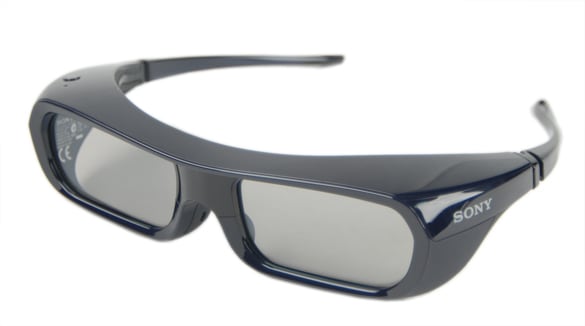
Yes, you will look like a dork with these on
Formats
{{section_header}}{{section.name}}{{/section_header}}
The LG 47LX6500 is a native 1080p display, but has no trouble displaying all the NTSC formats.
Viewing Angle
{{section_header}}{{section.name}}{{/section_header}}
The LG 47LX6500's viewing angle was better than most LCD displays, as has been the case for a few LGs we've reviewed this year. We found that the 47LX6500 could go as wide as 57 degrees (or 28 degrees from center in either direction) before losing a considerable amount of contrast. The Sony and Samsung LCD TVs compared here were less than half that. Only the Panasonic TC-P50VT20, a plasma display, topped it.
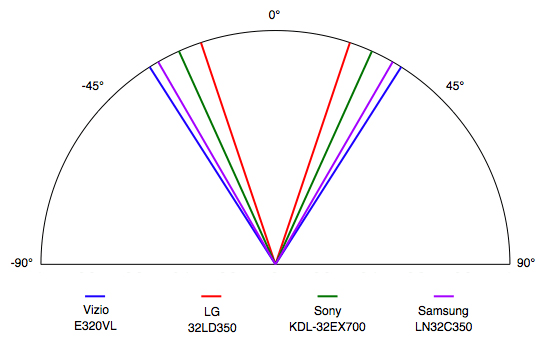
Reflectance
{{section_header}}{{section.name}}{{/section_header}}
When exterior light hits the screen on the LG 47LX6500, there's not too much of a reflection. It's a welcome relief, as many LCD screens reflect light back like a mirror. Reflections on this screen appear as a soft glow, and that's only if the light source is hitting it dead-on. If the light is coming on at an angle, the effect is minimized.
Video Processing
{{section_header}}{{section.name}}{{/section_header}}
Different video processing options are presented to you depending on which mode the TV is in. Below is the complete list.
Calibration
{{section_header}}{{section.name}}{{/section_header}}
The LG 47LX6500 has several preset modes. We used the 'Expert Control' setting, which allowed us full access to all the processing features – mostly beneficial so we can turn them off. Unusually, this mode allows control points as fine as both horizontal and vertical sharpness settings.

All of our calibration is done in conjunction with the DisplayMate software.
](http://www.displaymate.com/)
Video Modes
{{section_header}}{{section.name}}{{/section_header}}
The LG 47LX6500 offers several presets, if you don't feel like the hassle of custom calibration.
Ergonomics & Durability
{{section_header}}{{section.name}}{{/section_header}}
The LG 47LX6500 comes with a good, solid remote control. It's quite long and thin, but feels solid enough for occasional use. More than likely, you'll use the remote for your cable box far more frequently.
Button Layout & Use
{{section_header}}{{section.name}}{{/section_header}}
The buttons on the remote control are primarily soft rubber with a lot of key travel (the distance you have to push a button down to hit bottom). The exception is a grouping of buttons that controls the menu. These are faster, snappier buttons more tightly grouped together. You can race through the menu much faster, and we wish they'd just made the rest of the remote feel like this.
Programming & Flexibility
{{section_header}}{{section.name}}{{/section_header}}
The remote control that ships with the LG 47LX6500 can be used with other LG AV devices bearing the 'Simplink' logo.
Connectivity
{{section_header}}{{section.name}}{{/section_header}}
Input Ports (8.0)
The LG 47LX6500 has a number of ports, located in the back and the left side of the TV. Notable ports include: 4 HDMIs, 3 components, LAN, and 2 USB ports, making is a great TV for high-end users and lots of HD and multimedia inputs.
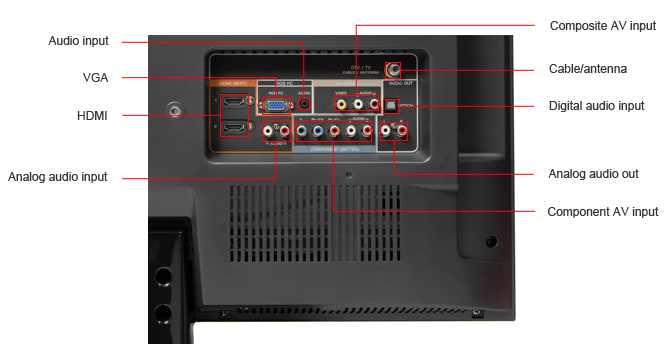
All the ports are well-labeled and easily accessible, thanks to the swivel base. Well, at least they're easy to see. Because of the incredibly thin frame, the ports that face out on the side can be tough to squeeze into. In fact, the component video port requires an adapter (included).
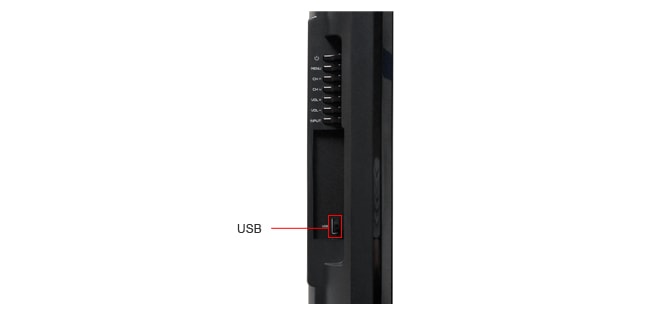
Output Ports (3.0)
The LG 47LX6500 has three output ports, a digital analog out, a headphone out (functions as an analog audio out, as well), and a Wireless Controller.
Other Connections (7.0)
The LG 47LX6500 includes a LAN ethernet port on the back, and is WiFi-ready, using either of the USB ports and a separately purchased dongle.
Media (2.0)
The LG 47LX6500 has two USB ports, both located on the left side. They can read USB thumb drives for music, photos, and video clips.
{{product.manufacturer_specs['Connectivity Tour Image 3']}}
Placement
{{section_header}}{{section.name}}{{/section_header}}
Due to the thin facade of the LG 47LX6500, the ports on the side can be a tight squeeze. If you have a fat HDMI cable or USB thumb drive, it might not fit.
Audio Quality
{{section_header}}{{section.name}}{{/section_header}}
The LG 47LX6500 has two built-in speakers, like nearly all HDTVs. And like all HDTVs (at least the ones we've tested) the audio quality is not nearly as good as a standalone 5.1 or 7.1-channel audio system. The built-in speakers were sufficient for regular TV viewing, if you're not too discerning, but it certainly lacks the 'oomph' that you want for movies. That's because speakers of this size simply can't deliver the desired bass frequencies.
There are plenty of audio options to modulate the sound. You can boost the vocals, turn the surround sound emulator on and off, and choose from a number of preset modes. We liked the 'Standard' preset best for movie watching, as the 'Movie' preset seemed to remove too much of the midtones.
Menu Interface
{{section_header}}{{section.name}}{{/section_header}}
The menu on the LG 47LX6500 and other LGs takes a slightly different tact than many manufacturers. When you first hit the 'Menu' button on the remote, a grid appears on the screen with options for several sub-menus. From here, selecting any of these brings up a more traditional, vertically-oriented menu system.
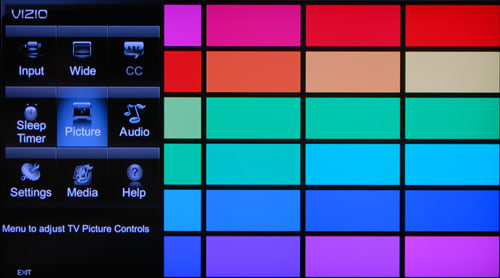
The menus are extremely easy, and even users with limited tech experience should be able to maneuver their way through.
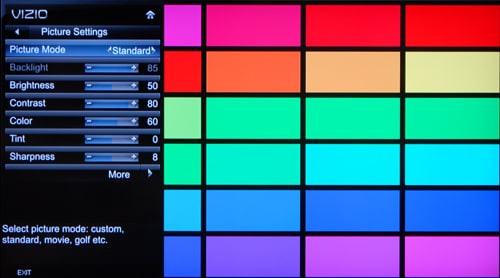
Instruction Manual
{{section_header}}{{section.name}}{{/section_header}}
The instruction manual that ships with the LG 47LX6500 is only a short primer, and all the TV's features are not covered in depth. Unfortunately, we were not able to find a downloadable version of the manual that worked. You'll just have to experiment with all the settings and see what they do.
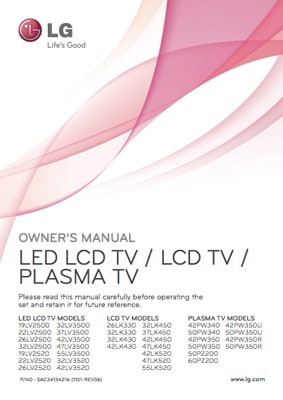
A manual for so many TV models, they have to be further categorized by type.
Internet Features
{{section_header}}{{section.name}}{{/section_header}}
The LG 47LX6500 is not as replete in its streaming content options as Sony, but what it does offer may be good enough. Most importantly, the latest LGs have Netflix and YouTube. That covers almost all the best content (or worst, depending on your views on YouTube). In addition, you get Vudu pay-per-view movies and Picasa photo sharing.
Yahoo offers a small line-up of widgets for weather, news, and the like, but we found the interface laggy and awkward. It's far faster and more elegant to use your phone or computer.
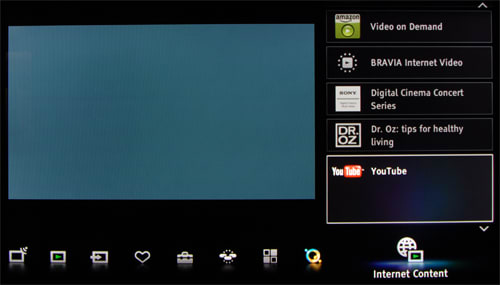
Local Media Playback
{{section_header}}{{section.name}}{{/section_header}}
The LG 47LX6500 will display photos if they're loaded on a USB drive and plugged into either of the USB ports. The interface is very simple, and can create slideshows to show off at parties.

The music and video interface is much the same as the photo playback. When you pop in a USB thumb drive, a screen pops up asking you if you'd like to access the data within. Choose photos, music, or video, and the matching content types are listed. You can make playlists for any type of media.
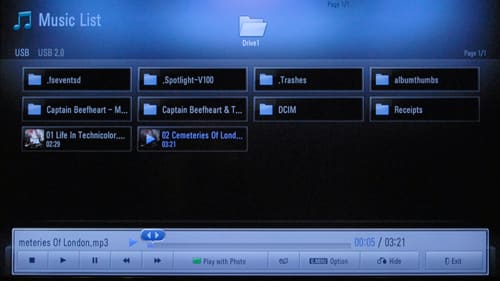
Other Media
{{section_header}}{{section.name}}{{/section_header}}
The LG 47LX6500 does not play any other type of media.
Power Consumption
{{section_header}}{{section.name}}{{/section_header}}
The LG 47LX6500 is an average power-eater. Like most LCDs this year, the cost of operation is getting a little cheaper. And like any LCD, you can always lower the backlight if you think the electric bill is getting a little high.
The chart below shows the cost comparison with similar TVs.
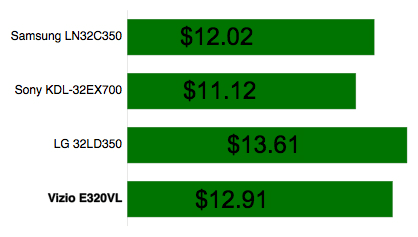
Value Comparison
{{section_header}}{{section.name}}{{/section_header}}
Priced exactly the same, at $2699 (MSRP), the LG 47LX6500 and Sony KDL-46HX800 are duking it out for your wallet. If you're interested in these TVs already, it's probably because of the 3D element, so let's clear this up, first. The Sony HX800 series is 3D-ready, meaning the screen is capable of displaying 3D. In order to actually watch it, you have to separately purchase 3D glasses and a 3D transmitter bar to sync the screen and the glasses. The LG 47LX6500, like most of the 3D TVs we've reviewed, has the transmitter built in, but still needs separately purchased glasses.
The missing transmitter on the Sony seems like a petty exclusion, since people purchasing the TV obviously want 3D. We're tempted to swing our vote towards LG on that point alone. But the Sony does offer much better blacks and contrast ratio. On the counterpoint, the LG has better color performance and a wider viewing angle. In terms of online content, nobody can beat Sony's breadth of choices, but if you don't need anything beyond Netflix, LG suffices just fine.
Overall, the LG offers slightly more value for the dollar, but the performances are pretty evenly drawn. They're both good TVs.
Blacks & Whites
{{section_header}}{{section.name}}{{/section_header}}
The LG 47LX6500 had a very weak black level compared to the other three TVs here, which hurt its contrast ratio score considerably. As you can see from the chart below, the LG is lagging in this area. The Sony HX800 comes out well ahead.

Color Accuracy
{{section_header}}{{section.name}}{{/section_header}}
The Sony KDL-46HX800 lagged a little in maintaining a consistent color temperature, but the difference would be hard to spot. In the RGB color curve test, both TVs performed very well.
Motion
{{section_header}}{{section.name}}{{/section_header}}
The motion performance of the Sony HX800 outperformed the LG 47LX6500 in most respects, offering smoother motion with less artifacting. In order to get the most out of both TVs, you should try experimenting with the motion processing features (TruMotion and MotionFlow from LG and Sony, respectively).
Viewing Effects
{{section_header}}{{section.name}}{{/section_header}}
The LG 47LX6500 had a much wider viewing angle than the Sony KDL-46HX800 – twice as wide, in fact.
Connectivity
{{section_header}}{{section.name}}{{/section_header}}
The LG 47LX6500 has an advantage over the Sony HX800 when it comes to connectivity, offering an additional component AV input, an additional USB port, and (should you need them) RS-232C and a Wireless Controller jack.
Other Comparisons
{{section_header}}{{section.name}}{{/section_header}}
The Sony KDL-46HX800 was not a great 3D performer, but the LG 47LX6500 was worse in its cross-talk issues. The moral of the story: Do not want.
Value Comparison
{{section_header}}{{section.name}}{{/section_header}}
The Samsung UN46C8000 is a more unusual design than most TVs, however the LG 47LX6500 is also an attractive design. You'll have to pick whether you prefer black plastic or faux brushed aluminum. The Samsung is an outstanding 2D performer, in most regards. The LG has better color performance, but we think the contrast ratio on the Samsung makes for a more pleasing picture. The Samsung had its performance issues with 3D, but was significantly better than the LG. With all these facts at hand, we'd have to pick the Samsung.
Blacks & Whites
{{section_header}}{{section.name}}{{/section_header}}
The contrast ratio of the Samsung UN46C8000 is outstanding, at 4025:1. It's much better than the LG 47LX6500, due to the poor performance of the LG's black level.

Color Accuracy
{{section_header}}{{section.name}}{{/section_header}}
The Samsung takes a big dive on color temperature consistency in the darkest portion of the signal. The LG 47LX6500 was also a better performer in the RGB color curve, offering smoother color transitions.
Motion
{{section_header}}{{section.name}}{{/section_header}}
The Samsung UN46C8000 showed a slight improvement over the LG 47LX6500 in motion performance, but there was not so much difference that one is vastly better than the other.
Viewing Effects
{{section_header}}{{section.name}}{{/section_header}}
The LG 47LX6500 offers a much wider viewing angle than the Samsung UN46C8000.
Connectivity
{{section_header}}{{section.name}}{{/section_header}}
The Samsung UN46C8000 has an unusually thin frame, and because of this the ports are a little weird. There are only a few points of connectivity, compared to most TVs, and most of the ports that survived require a proprietary adapter.
Other Comparisons
{{section_header}}{{section.name}}{{/section_header}}
The 3D performance of the Samsung was not entirely laudatory. We witnessed numerable, obvious cross-talk issues. But the 3D effect on the LG is so clearly broken and lacking in options to tweak the performance, we cannot recommend the LG 47LX6500 as a viable 3D TV.
Value Comparison
{{section_header}}{{section.name}}{{/section_header}}
The Panasonic TC-P50VT20 is a very good plasma TV, and it's 3D performance has thus far been the most immersive of any we've seen in the first-generation models. However, it's dim screen puts a damper on everyday viewing, and when the 3D glasses are on, it's downright difficult to see details. The LG 47LX6500 is a little more expensive, but it's a very good TV in its own right, and much brighter. The LG can't beat the Panasonic for black levels, but in most other regards, it's a match.
Blacks & Whites
{{section_header}}{{section.name}}{{/section_header}}
The Panasonic TC-P50VT20 had an amazingly low black level that easily outstripped the three LCD televisions in the chart below. However, peak brightness was quite poor (and even worse in 3D mode), making for a weak contrast ratio. It's still better than the LG 47LX6500, which had no problem with the whites, but had very poor black levels.

Color Accuracy
{{section_header}}{{section.name}}{{/section_header}}
In the color temperature consistency tests, the Panasonic TC-P50VT20 took a nose dive at the darkest end of the signal. For the RGB color curve test, we preferred the smooth color transitions of the LG 47LX6500. The Panasonic's transitions were much shakier, so you can expect to see more instances of color banding.
Motion
{{section_header}}{{section.name}}{{/section_header}}
The motion performance on the plasma Panasonic TC-P50TV20 showed a slight advantage over the three LCD TVs we compared it against. It's generally one of the advantages that plasmas have.
Viewing Effects
{{section_header}}{{section.name}}{{/section_header}}
The other big advantage of plasma displays is a wide viewing angle. LCDs can't even come close, as you can see from the chart below.
Connectivity
{{section_header}}{{section.name}}{{/section_header}}
The LG 47LX6500 and Panasonic TC-P50VT20 have different arrangements and options for ports, and neither is distinctly better than the other. The LG has one more component AV, but the Panasonic has one more composite AV, as well as a media card slot.
Other Comparisons
{{section_header}}{{section.name}}{{/section_header}}
The Panasonic vastly outperforms the LG 47LX6500 in its 3D performance. The Panasonic definitely had some brightness issues, but you can clear that up with some menu adjustments. The LG 47LX6500 is simply riddled with cross-talk issues and there's absolutely nothing you can do about it.
Conclusion
The LG 47LX6500 ($2699 MSRP) is a good-to-very-good television, as far as its 2D performance is concerned. The black level was weak, but the contrast ratio is acceptable. The color performance is outstanding, once again showing where LG's strength's lie.
The LG 47LX6500 is not, however, a good 3D television, and we have to imagine that's why many of you are reading this review. The cross-talk is simply unacceptable. We ran tests under a variety of conditions and equipment pairings to give it the best chances, and it continued to let us down.
For this simple reason, it's hard to recommend the LG 47LX6500. There are plenty of standard, 2D televisions that cost less, and a growing number of 3D TVs that are better at delivering the 3D experience.
Model Series Comparison
{{section_header}}{{section.name}}{{/section_header}}
The LX6500 series has just two models, a 47-inch and a 55-inch. Both are 3D TVs, and neither come with glasses included.
Photo Gallery
{{photo_gallery "Front Tour Image", "Back Tour Image", "Sides Tour Image", "Stand Photo", "Controls Photo", "Remote Control Photo", "Connectivity Tour Image 1", "Connectivity Tour Image 2", "Connectivity Extra Photo", "Menu Main Photo", "Menu 2 Photo", "Internet Features 1 Photo", "Internet Features 2 Photo", "Internet Features 3 Photo", "Local Media Playback 1 Photo", "Local Media Playback 2 Photo"}}
Ratings & Specs
{{manufacturer_specs_table}}
Meet the tester
David Kender oversees content at Reviewed as the Editor in Chief. He served as managing editor and editor in chief of Reviewed's ancestor, CamcorderInfo.com, helping to grow the company from a tiny staff to one of the most influential online review resources. In his time at Reviewed, David has helped to launch over 100 product categories and written too many articles to count.
Checking our work.
Our team is here to help you buy the best stuff and love what you own. Our writers, editors, and experts obsess over the products we cover to make sure you're confident and satisfied. Have a different opinion about something we recommend? Email us and we'll compare notes.
Shoot us an email